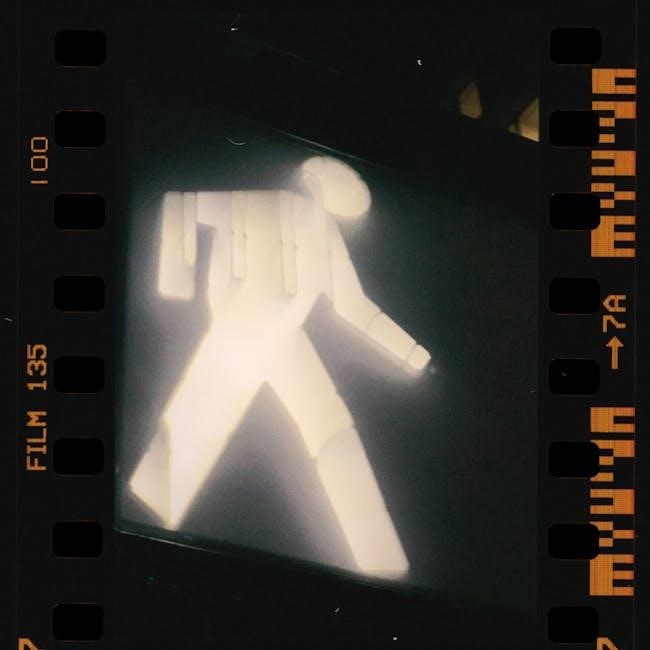Film analysis is a foundational skill for understanding cinema‚ involving the breakdown of cinematic elements like lighting‚ editing‚ and sound to explore themes and narratives effectively.
What Is Film Analysis?
Film analysis is a detailed examination of a film’s components‚ exploring themes‚ narrative structure‚ and cinematic techniques like lighting‚ sound‚ and editing. It involves critical thinking and breaking down the film into its visual and auditory elements to understand its message. Unlike a review‚ analysis focuses on how these elements work together to convey meaning. It requires persuasive writing‚ supported by evidence‚ to interpret the filmmaker’s intent and the film’s impact. By analyzing these aspects‚ viewers gain a deeper understanding of the film’s artistic and cultural significance.
Key Terminology for Writing About Film
Understanding key film terminology is essential for effective analysis. Terms like cinematography (camera techniques)‚ mise-en-scène (setting and composition)‚ editing (how scenes are arranged)‚ and sound design (music‚ dialogue‚ effects) are fundamental. Other terms include narrative structure (story organization)‚ theme (central idea)‚ and genre (category‚ e.g.‚ horror‚ comedy). Familiarity with these concepts helps break down a film’s visual and auditory elements‚ enabling deeper interpretation and critique. Using precise terminology enhances clarity and professionalism in film writing‚ making analysis more engaging and insightful for readers.
Top Tips for Writing About Film
Watch the film multiple times‚ express your opinions with supporting evidence‚ consider your audience‚ and analyze acting‚ cinematography‚ and sound to craft insightful‚ well-rounded critiques.
Watch the Film Multiple Times
Viewing a film multiple times ensures a deeper understanding of its themes‚ characters‚ and cinematic techniques. On the first watch‚ focus on the overall narrative and emotional impact. Subsequent viewings allow you to analyze specific elements like cinematography‚ lighting‚ and sound. Pay attention to details you might have missed initially‚ such as symbolic imagery or subtle character development. Taking notes during each viewing helps capture insights and supports a more comprehensive analysis. This approach enriches your interpretation and provides a solid foundation for writing a well-informed critique.
Express Your Opinions and Support Your Criticism
Film analysis is a form of persuasive writing‚ requiring you to share your interpretations and opinions about the film. Clearly state your viewpoint and back it with evidence from the film‚ such as specific scenes‚ dialogue‚ or cinematic techniques. Avoid vague statements and ensure your criticism is constructive and well-supported. This approach makes your analysis engaging and credible‚ helping readers understand your perspective while encouraging them to think critically about the film themselves.
Consider Your Audience
When writing about film‚ it’s crucial to tailor your analysis to your audience. Determine whether you’re addressing film enthusiasts‚ students‚ or general readers and adjust your language accordingly. Avoid overly technical jargon unless your audience is familiar with it. Be mindful of cultural references and ensure accessibility. This ensures your analysis resonates effectively‚ making it relatable and engaging for your readers. Understanding your audience helps you communicate your ideas clearly and effectively‚ enhancing the overall impact of your film analysis or review.

Understanding Film Elements
Film elements like cinematography‚ lighting‚ and sound are crucial for storytelling. They shape the narrative‚ evoke emotions‚ and enhance the viewer’s experience‚ making them essential for analysis.
Cinematography‚ Lighting‚ and Sound
Cinematography captures the visual essence of a film‚ while lighting sets the mood and highlights key elements. Sound‚ including dialogue and music‚ enhances emotional impact and immerses the audience. Together‚ these elements create a cohesive storytelling experience‚ guiding viewer interpretation and emotional response. Analyzing these components reveals how filmmakers convey themes and narratives effectively. Paying attention to these details is crucial for a deeper understanding of the film’s artistic and technical achievements‚ making them essential elements to explore in any film analysis or review. Proper use of these elements significantly contributes to the film’s overall success and audience engagement.
Film Themes and Narrative Structure
Film themes explore universal ideas and messages‚ often reflecting societal issues or human emotions. Narrative structure organizes the story‚ guiding the audience through setup‚ conflict‚ and resolution. Analyzing themes requires identifying recurring motifs and their significance‚ while narrative structure involves examining plot devices‚ pacing‚ and character development. These elements work together to create a meaningful and engaging cinematic experience‚ offering insights into the director’s vision and the film’s cultural context. Understanding these aspects enhances critical analysis and appreciation of the film’s artistic and storytelling impact‚ making them vital components in any film analysis or review. They shape the audience’s connection to the story and its underlying message.

Film Review vs. Film Analysis
A film review shares personal opinions on a film’s quality‚ while analysis dives deeper into its elements‚ themes‚ and techniques to explore its meaning and significance.
How to Avoid Excessive Plot Summary
To avoid excessive plot summary‚ focus on analyzing key scenes and elements rather than recounting the entire storyline. Highlight specific moments that illustrate themes or character development. Use descriptive language to convey the mood and tone set by cinematography‚ lighting‚ and sound. Instead of listing events‚ explore how the director’s choices enhance the narrative. Concentrate on the film’s deeper meanings and symbolic elements. This approach keeps your analysis engaging and insightful‚ offering a critical perspective rather than a mere retelling of the plot.
How to Write a Movie Synopsis
A movie synopsis briefly introduces the main character‚ their goal‚ and the central conflict‚ providing a concise overview of the story’s key elements and themes.
Keep It Brief and Focused
To craft an effective movie synopsis‚ keep it concise and centered on the core story. Aim for a length of one to two pages‚ focusing on the main character‚ their primary goal‚ and the central conflict driving the narrative. Highlight key events that propel the story forward and conclude with the resolution or climax. Avoid unnecessary details like subplots or overly descriptive language. Ensure the synopsis is clear‚ engaging‚ and provides a snapshot of the film’s essence without revealing every twist. This approach ensures readability and maintains the audience’s interest while staying true to the film’s heart.
Write in the Present Tense
When crafting a movie synopsis‚ use the present tense to create an engaging and immediate narrative. This approach makes the story feel active and dynamic‚ drawing readers into the film’s world. Focus on the main character’s goal and the central conflict driving the plot. Avoid excessive details about subplots or minor elements. Instead‚ highlight key events and turning points that define the story’s progression. Keep the language clear and concise‚ ensuring the synopsis captures the essence of the film without revealing every twist. This method ensures the synopsis remains compelling and informative‚ providing a vivid snapshot of the movie’s core themes and structure.

Common Mistakes to Avoid
Avoid overloading your analysis with personal bias‚ ensuring your critique remains objective and evidence-based. Focus on film elements rather than unrelated opinions for clarity and effectiveness.
Overloading with Personal Bias
One common mistake in film writing is overloading your analysis with personal bias‚ which can overshadow objective critique. While opinions are essential‚ they should be grounded in evidence from the film itself. Avoid letting personal feelings dominate your analysis‚ as this can make your arguments appear subjective and less credible. Instead‚ strive for a balanced approach that acknowledges both strengths and weaknesses. Focus on specific cinematic elements like cinematography‚ dialogue‚ or themes to support your points. This ensures your analysis remains insightful and respectful‚ providing value to readers while maintaining professionalism and objectivity in your writing.
The Creative Process of Film Writing
Film writing begins with developing a story idea‚ outlining the plot‚ and creating compelling characters and dialogue to bring the narrative to life on screen effectively.
Developing Your Story Idea
Developing a story idea involves brainstorming themes‚ characters‚ and conflicts. Start by identifying the core theme and how it will resonate with audiences. Consider the protagonist’s journey and the central conflict that drives the plot. Research real-life events or draw from personal experiences to add authenticity. Outlining key scenes and dialogue helps shape the narrative. Revise and refine your concept to ensure clarity and originality. Collaboration with others can also provide fresh perspectives‚ enhancing the story’s depth and emotional impact. This process lays the foundation for a compelling screenplay.
Outlining the Plot
Outlining the plot involves breaking down your story into a structured sequence of events. Start by identifying the three-act structure: setup‚ confrontation‚ and resolution. Create a treatment‚ a detailed prose outline‚ to visualize the flow. Include key scenes‚ dialogue‚ and character arcs to ensure coherence. Use slug lines (INT/EXT‚ location‚ time) for clarity. Keep your outline concise but informative‚ focusing on pivotal moments and transitions. Regularly revise and refine to maintain pacing and emotional impact. This process ensures your story remains focused and engaging from start to finish.

Engaging with Film Practically
Engage with film by making short films‚ experimenting with techniques‚ and collaborating on projects. Practical experience offers insights into filmmaking processes and enhances storytelling skills.
Try Making Your Own Short Film
Creating a short film offers hands-on insight into storytelling and cinematic techniques. Start with a simple idea‚ focusing on a concise narrative. Use accessible tools like smartphones or basic cameras to bring your vision to life. Scripting‚ planning‚ and collaboration with others enhance creativity. This practical exercise reveals the challenges of filmmaking‚ deepening your understanding of pacing‚ dialogue‚ and visual composition. By making a short film‚ you gain invaluable experience that enriches your ability to critique and analyze films effectively‚ providing a unique perspective on the filmmaking process.
